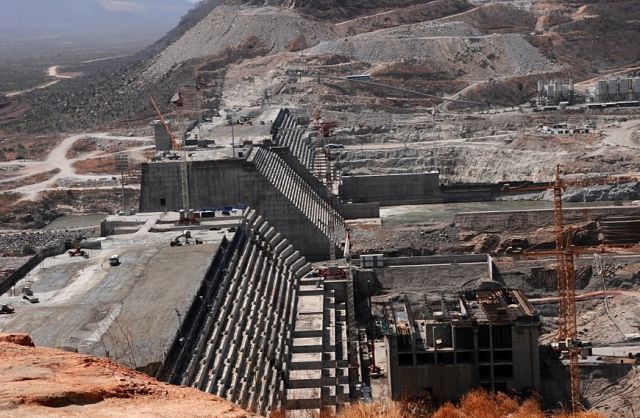 Ethiopia's multi-billion dollar self-funded Grand Ethiopian Renaissance Dam (GERD), which is currently under construction on the Blue Nile river in the Benishangul-Gumuz region, will be the largest hydroelectric power plant in Africa when completed, as well as one of the top 10 largest in the world. (Photo via Twitter)
Ethiopia's multi-billion dollar self-funded Grand Ethiopian Renaissance Dam (GERD), which is currently under construction on the Blue Nile river in the Benishangul-Gumuz region, will be the largest hydroelectric power plant in Africa when completed, as well as one of the top 10 largest in the world. (Photo via Twitter)
By ELIAS MESERET
ADDIS ABABA, Ethiopia — Officials from Ethiopia, Egypt and Sudan early Wednesday announced progress in talks on what will be Africa’s largest hydroelectric dam.
The foreign ministers of Egypt and Ethiopia and Sudan’s water resources minister said they will set up a scientific study group to consult on the filling of Ethiopia’s $5 billion Grand Ethiopian Renaissance Dam on the Nile River. They also confirmed that leaders from the three nations will meet every six months for consultations.
The latest talks came after a round of negotiations last week in Cairo failed. More high-level talks are set for July 3 in Cairo.
Egypt fears too much of the Nile’s waters could be retained each year, affecting its agriculture. Ethiopia maintains that the dam’s construction will not reduce Egypt’s share of the water and that it will help Ethiopia’s development, pointing out that 60 million of its citizens don’t have access to electricity.
“We have charted a road map that, if successful, will be able to break difficulties that we have been facing,” Egypt’s Foreign Minister Sameh Shoukry told reporters after the marathon talks.
“One step forward to Ethiopia,” the country’s foreign affairs spokesman, Meles Alem, told The Associated Press on Wednesday.
The mega-dam is now more than 63 percent complete. Once complete it will generate about 6,400 megawatts, more than doubling Ethiopia’s current production of 4,000 megawatts.
According to a document obtained by the AP, the scientific group will discuss and develop “various scenarios related to the filling and operation rules in accordance with the principle of equitable and reasonable utilization of shared water resources while taking all appropriate measures to prevent the causing of significant harm.”
—
Join the conversation on Twitter and Facebook.

























